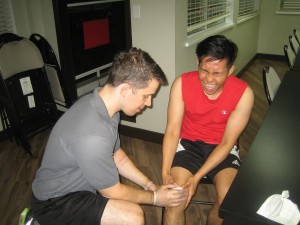A torn meniscus is a common form of knee joint injury. It occurs once the cartilage that provides cushioning between the femur and tibia are torn.
The injury is typically brought about by any sport such as football, basketball or running where the knee is forcefully twisted or rotated.
What are the usual causes?
Some of the usual causes for a torn meniscus include the following:
- Muscular imbalances
- Engaging in sports that cause the knee joint to forcefully rotate or twist
- Lifting heavy objects or squatting
- Muscle weakness
Apply an ice pack or cold compress on the affected knee to reduce the pain and swelling.
What are the indications of a torn meniscus?
If an individual has a torn meniscus, the following symptoms are present:
- Knee pain while walking
- Perceivable popping sensation at the time of injury
- Stiffness or swelling of the joint
- Inability to place any weight on the knee
- Tenderness of the knee joint if light pressure is applied
- Difficulty in straightening the knee or kneeling
Management
When dealing with a torn meniscus, it can be managed both conservatively or with surgery. Nevertheless, the treatment is based on the form of tear, size and site of injury.
The conservative measures for a torn meniscus include the RICE method and other measures:
- Rest – any activity that worsens the condition must be avoided. The individual is instructed to take a break from any physical activity until the symptoms settle.
- Ice – apply an ice pack or cold compress on the affected knee to reduce the pain and swelling.
- Compression – using an elastic compression bandage can prevent further swelling and blood loss
- Elevation – raising the knee joint can help lower the swelling
Aside from the RICE method, other treatment measures include:
- Non-steroidal anti-inflammatory drugs (NSAIDs) can be given to reduce the knee pain.
- Corticosteroid injections can be given to provide brief relief to the symptoms as well as help improve the range of motion.
- Physical therapy to restore strength and flexibility
- Taping of the kneecap or using a specialized brace during sports for added support to the knee
- Shoe orthotics can be worn to relieve the pain.
In case surgery is necessary for a torn meniscus, some of the options include knee arthroscopy, meniscus repair and meniscectomy.
Quick Note / Disclaimer
The material posted on this page on a torn meniscus is for learning and educational purposes only. To learn to recognize the signs and how it is treated, register for a first aid and CPR course with Toronto First Aid.

